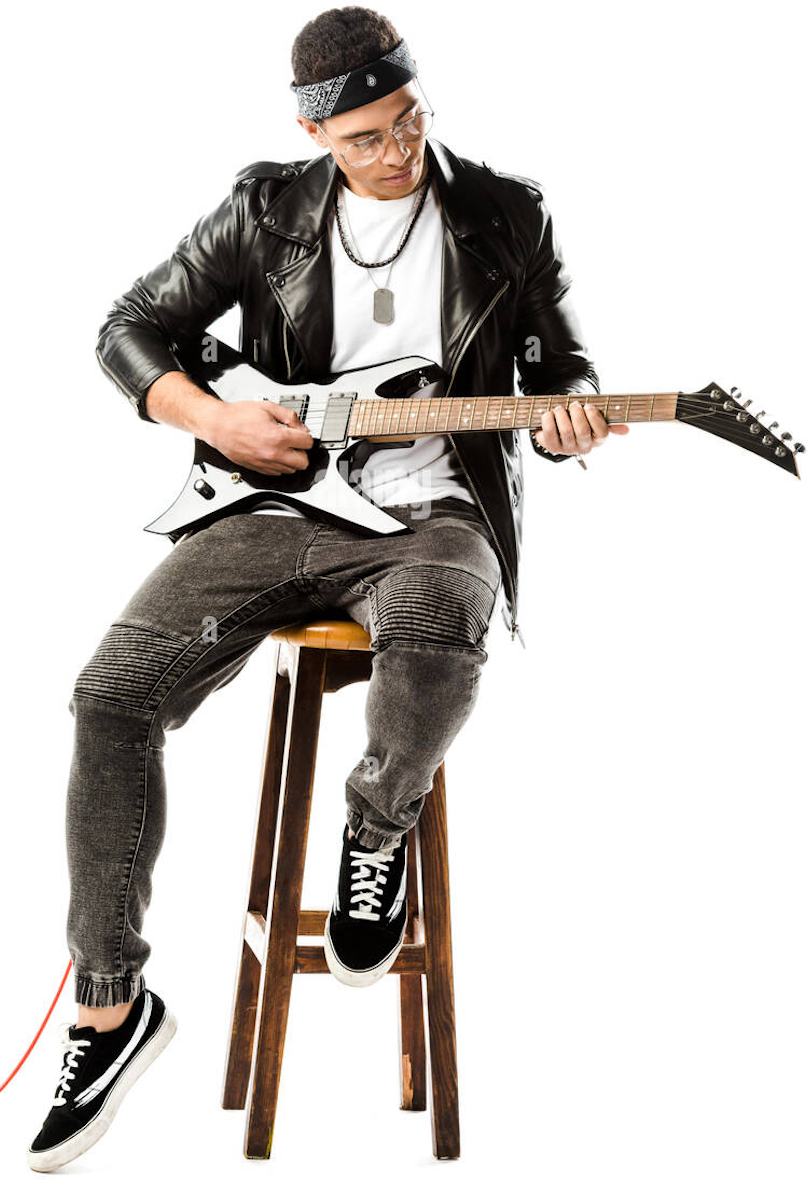Holding a guitar might seem like a simple thing- you just pick up the guitar and hold it! But we hate to break it to you that guitar positioning is not that obvious and, in fact, is one of the most crucial beginner guitar skills that you must acquire to be able to learn how to play the instrument.
So, in today’s guitar lessons agenda, we will:
- Guide you step-by-step over posturing yourself when playing the guitar
- Discuss how to hold a guitar when in a seated or a standing position

How To Hold A Guitar?
Following we will be providing you with a breakdown of how to hold a guitar properly. This breakdown is from a right-hand guitarist’s perspective, so if you are left-handed, do the opposite for all the steps.
Step 1: Resting The Guitar
For beginners learning to hold the electric guitar in the right way, it is always advisable to rest it on your right leg. Although resting the guitar on the left leg is a classical approach, and people do it often, these players are proficient and know their way around the guitar.

Step 2: Stabilizing The Guitar
Once the guitar has been positioned on your leg, you stabilize it with your right arm. Do this by slightly placing your right arm over the top of the electric guitar. This technique is different for an acoustic guitar, where the right arm rests entirely over the guitar’s top, but for an electric guitar that has a more slender body, you should not burden the instrument with your arm’s weight.
Another thing to keep in mind when stabilizing the guitar is that the fretting hand should not be used to stabilize it. Instead, you should keep it free to play the strings.

Step 3: Guitar Leaning
Mostly, new guitar learners lean the guitar body towards themselves while trying to support it. As a result of this, you will have to work harder to move your wrist around the guitar neck, causing unnecessary tension.
If you are leaning the guitar back, it is not your fault because it comes naturally to most beginners. However, since you are learning about guitar positioning, you should avoid doing this at all costs because if not corrected now, guitar leaning will become a bad habit, ruining your posture and playing technique.
Step 4: Posture
With guitar playing, hunching is something that comes inevitably to many guitarists. Whether you are just starting out with your guitar journey or have progressed, players should always try to remind themselves not to hunch. You would not want to play the guitar at the cost of ending up with a crooked back later in life.
Therefore, try not to lean your body over the instrument too much and make an effort to sit with your back straight. Often, you will hunch to check on your hand movement, but when you do so, remember to correct that hunch.
Seated Position
When seated comfortably on any item: a chair, sofa, or a high stool, you can hold the guitar in different positions. People are often concerned about what they should sit on, but this should not worry you. Instead you should be more focused on sitting up straight and without a bend in your back.

Open Legs Seating Position
A typical sitting position to hold the guitar is with your legs open, where the guitar will rest on your leg, supported and played by the subsequent arm and hand.
For example, if you place the guitar on the right leg, you also support it with your right arm while strumming with the right hand. Here, position the guitar so it does not lean back but sits below the chest.
Also, keep your back straight (do not hunch) and have your picking hand at a right angle to minimize any wrist tension that may occur when reaching for the strings.
Crossed Legs Seating Position
While some people may feel comfortable holding their guitar with their legs open, others would prefer to cross their legs. If you are strumming with your right hand, cross your right leg, and when strumming with the left hand, cross the left leg.
Again, do not forget to keep your back straight, your fretting hand free, and place it at a right-degree angle.
Important Pointers:
- When sitting with your legs crossed, you should make sure that your knees are crossed high enough to support the guitar so you can play it easily. Alternatively, when sitting with uncrossed legs, maintain an ideal distance between your guitar and your chin, keeping it below the chest.
- If your electric guitar has a dip, which most guitars do, rest it on the same leg as the strumming hand. This helps ensure the guitar remains in place and offers some additional support.
- While you must avoid leaning the guitar back against your chest, you can tilt it only slightly towards yourself for beginner’s ease.
- The elbow of your strumming hand should point outwards when rested on top of the guitar as it helps the wrist move conveniently across the strings.
- Try and have the fretting hand at 90 degrees or an acute angle because this aids in lessening the strain that is on the wrist: The lesser the strain, the more the comfortability of the fretting hand.

Standing Position
Playing the guitar in a standing position is a wholly new and different experience than when sitting, but for this you need to have a guitar strap to bind the guitar with.
In essence, there are not many differences between holding the guitar in a standing position and holding it when you are seated. Such as, even while standing, you have to make sure your back is straightened, you are not hunching much, the fretting hand’s elbow is either at a ninety-degree or an acute angle, and most importantly, the elbow of the strumming arm is tilted so that there is a smooth pivot point for pick positioning and strumming.
However, something that is additional to holding and playing the guitar when standing is the height at which you will place the guitar. The guitar should not be below your waist or, opposingly, close to your chin.
Rather, the guitar’s body should be placed at a comfortable, ideal height from where you can continue playing it conveniently without your back-hunching.

Important Pointers:
First and foremost, now there is an additional accessory required for you to hold the guitar when standing- the guitar strap- so you have to look out for the strap’s tightness or looseness. If the strap is loose, it will be low, and the guitar will be down almost reaching your knees, making you unable to play chords or grip the guitar neck.
No hunching with the guitar standing position too- stand upright!
The forearm should be angled and pointing outwards from the top corner of your guitar and not inwards.
While adjusting the guitar height, choose the height from where playing the guitar feels comfortable to you, a height from where you can move your hand over the fretboard without straining your wrist or facing other challenges.

Frequently Asked Questions (FAQS)
What is the best way to hold a guitar?
The best way to hold a guitar is to rest it on your right leg, with your right arm placed slightly on its top while your back remains upright and the fretting hand is at a ninety-degree angle or less.
Does it matter how I hold my guitar?
Yes, it matters how you hold your guitar because your posture regulates the way you play. If you hold the guitar inaccurately then playing the strings will not only be difficult but also result in wrist tension, impacting your overall performance.
What is the best posture to play guitar when sitting?
The best posture for holding a guitar is to sit with your back straight and your strumming arm at a ninety-degree or an acute angle.
Does sitting on a sofa impact my guitar playing?
Sitting on a sofa necessarily does not impact your guitar playing, but the way you sit. for example, if you sit in a relaxed position where you are slouching on the sofa, then you will face difficulties in playing chords and moving your hand around the fretboard.
Conclusion
Before we wrap up today’s lesson on how to hold a guitar, the only thing we would like to repeat for you to remember is that you must be controlling the guitar; the guitar should not be controlling you. This means that you hold the guitar such that you have maximum control over it and can play it easily.
